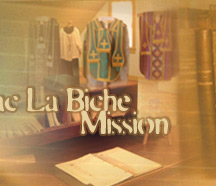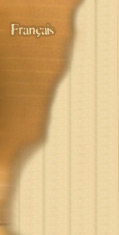ARTIFACTS
Archives and Library
Lac La Biche Mission
"Of all national assets, archives are the most precious, they are the gift of one generation to another and the extent of our care of them marks the extent of our civilization." Arthur Doughty
 Tabernacle from the Lac La Biche Mission
Tabernacle from the Lac La Biche Mission
Biblical Commentary – Lac La Biche Mission Collection
"When we are collecting books, we are collecting happiness." Vincent Starrett
Mike Maccagno with visiting school children at Lac La Biche Archives
(Photo courtesey of Dave Winger)
Prehistoric Indian pottery – Top photo on right
Dating to approximately A.D. 1520, recovered from archaeological  investigations
of Site GfPa-32 on Block Fox Island situated on Lac La Biche (Photo courtesy
of K. Connor-Learn).
investigations
of Site GfPa-32 on Block Fox Island situated on Lac La Biche (Photo courtesy
of K. Connor-Learn).
Projectile points – Bottom photo on right
Recovered from the shores of Lac La Biche.
A: Agate Basin type (ca.8500 B.C. – 5500 B.C.);
B and C: Oxbow type (ca. 3500 B.C – 1500 B.C.);
D and E: McKean type (ca. 2500 B.C – 1500 B.C.);
F, G and H: Duncan type (ca. 2000 B.C – 1500 B.C.);
I and J: Pelican Lake type (ca. 1000 B.C – 200 A.D.) (Courtesy of T. Maccagno);
K: Metal point dating to the Proto-historic recovered from Black Fox Island (Courtesey J.Tratch).
 Beads and copper kettle lugs characteristic of the late 1700’s early 1800’s recovered from River Lots 56 and 58 during
an archaeological search for Red Deers Lake House and Greenwich House. The
specimen (obverse and reverse) in photo top left is from River Lot 58; remaining
specimens are from River Lot 56. Raymond Diesel reports that in 1927 musket
balls, square spikes, and other artefacts on an early age were found in association
with the remains of the extremely old buildings and cellar depressions on
River Lot 58 (E.J. McCullough and M. Maccagno, “The Fur Forts of Lac
La Biche,” Unpublished Report, on file, Archaeological Survey of Alberta,
Edmonton, 1985).
Beads and copper kettle lugs characteristic of the late 1700’s early 1800’s recovered from River Lots 56 and 58 during
an archaeological search for Red Deers Lake House and Greenwich House. The
specimen (obverse and reverse) in photo top left is from River Lot 58; remaining
specimens are from River Lot 56. Raymond Diesel reports that in 1927 musket
balls, square spikes, and other artefacts on an early age were found in association
with the remains of the extremely old buildings and cellar depressions on
River Lot 58 (E.J. McCullough and M. Maccagno, “The Fur Forts of Lac
La Biche,” Unpublished Report, on file, Archaeological Survey of Alberta,
Edmonton, 1985).
The Calendric Tally Stone
In the late 1980s, Harry Mueller of Lac La Biche unwittingly
stumbled upon a rare artifact while collecting rocks for a flower garden.
His daughter, Jennifer, noticed that one of the stones was quite different.
It was a piece of ironstone about 12.5 cm long, 10 cm wide and 3.5 cm thick.
The surfaces were smooth and polished and along one edge twelve vertical lines
had been carefully cut into the stone. The stone also appeared to have a number
of figures carved on it. Ms. Mueller subsequently turned the stone over to
archaeologists for inspection. They have been speculating about the artifact
ever since.
Recently, however, Gloria Fedirchuk, an archaeologist familiar with the Lac La Biche area, has suggested that the artifact might be either a medicine stone or a calendric tally stick. Medicine stones were often carried by Native people.
They were usually associated with a personal guardian
spirit, often a bird or animal. Tally sticks were used to measure the phases
of the moon. Since the Mueller artifact contains both figures and notches
speculation about what it is will likely continue.

 Two views of the strange artifact Harry Mueller acquired while building a flower garden. His daughter, Jennifer, was the first person to recognize its potential significance.
Two views of the strange artifact Harry Mueller acquired while building a flower garden. His daughter, Jennifer, was the first person to recognize its potential significance.
Photo courtesy of Gloria Fedirchuk
p. 22 Lac La Biche Chronicles: A Record in Stone
© 2003 Société culturelle Mamowapik and the Lac La Biche Mission Historical Society (All Rights Reserved)






